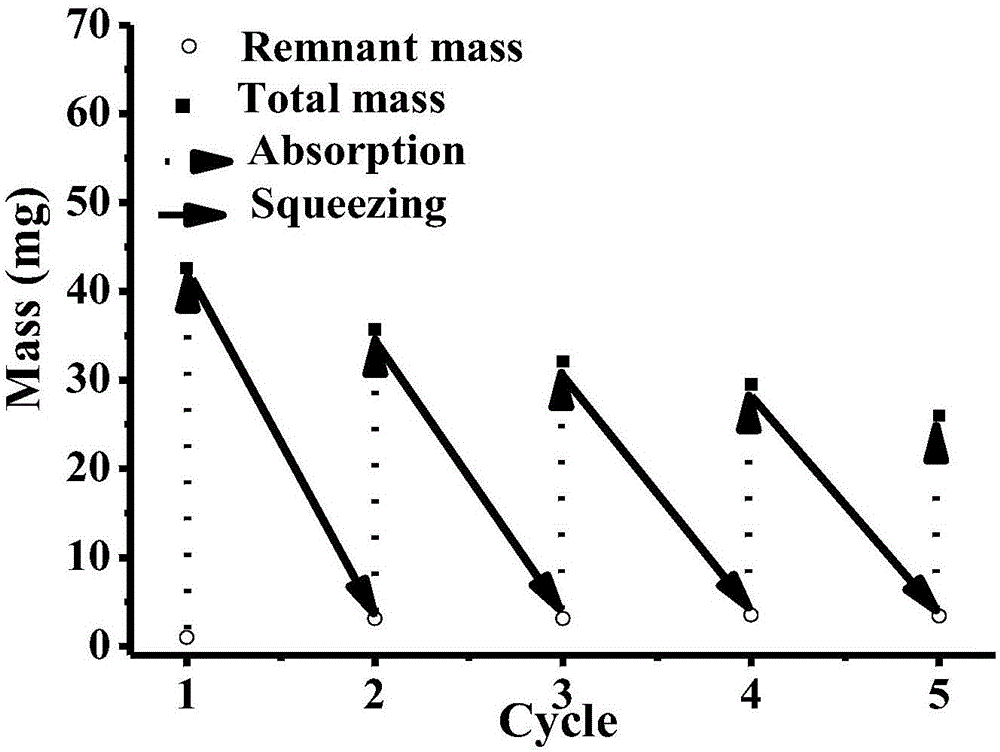Nanometer porous aerogel oil absorption material and method for preparing same
An oil-absorbing material and nanoporous technology, applied in the field of polyimide aerogel oil-absorbing material and its preparation, can solve the problems of high cost of synthetic polymer materials, complicated preparation process, low oil absorption capacity, etc., and achieve excellent flame retardant properties , the preparation steps are simple, the effect of high oil absorption
- Summary
- Abstract
- Description
- Claims
- Application Information
AI Technical Summary
Problems solved by technology
Method used
Image
Examples
Embodiment 1
[0031] 1) At room temperature, fully dissolve 24g of 4,4'-diaminodiphenyl ether (ODA) in 50g of N,N-dimethylformamide (DMF) in a three-necked flask, and stir until the solution is clear and no particles are seen; Then, it is evenly added into pyromellitic dianhydride (PMDA) three times to obtain a polyamic acid solution. After continuing to stir and react for about 4 hours, slowly pour into deionized water for precipitation, filter and dry to obtain solid polyamic acid powder. The pyromellitic dianhydride (PMDA) and ODA are in equimolar amounts, and the mass is 26.16g.
[0032] 2) Weigh 3 g of polyamic acid powder, add 1.44 g of triethylamine, and dissolve in 15.56 g of deionized water to prepare a polyamic acid salt solution.
[0033] 3) Pour the polyamic acid salt solution prepared in step 2) into a circular mold, freeze in a -20°C refrigerator for about 12 hours, and then freeze-dry for 48 hours under a vacuum of 4Pa~6Pa, and the freezing temperature is -196 ℃, heat imidi...
Embodiment 2
[0035] In the first step, choose hexafluorodianhydride (6FDA) and ODA to react in equimolar proportions, and use N-methylpyrrolidone (NMP) as the polar solvent to obtain a polyamic acid solution with a concentration of 8% by mass. The polyamic acid solution was poured into deionized water for precipitation, and dried to obtain polyamic acid powder.
[0036] In the second step, the polyamic acid powder is dissolved in a mixed solution of triethylamine and water to obtain a polyamic acid salt solution with a concentration of 0.1% by mass. The mass ratio of the polyamic acid powder to triethylamine is 1:0.48.
[0037] The third step is to pour the polyamic acid salt solution into the mold for freezing and shaping, specifically cooling in dry ice for 10 seconds. Then vacuum 2Pa, freeze-dry at -5°C for 120h. A nanoporous airgel oil-absorbing material is obtained.
Embodiment 3
[0039] In the first step, equimolar reaction of pyromellitic dianhydride and ODA is selected, and the polar solvent is N-methylpyrrolidone (NMP) to obtain a polyamic acid solution with a concentration of 12% by mass. The polyamic acid solution was poured into deionized water for precipitation, and dried to obtain polyamic acid powder.
[0040] In the second step, the polyamic acid powder is dissolved in a mixed solution of tetraethylamine and water to obtain a polyamic acid salt solution with a concentration of 20% by mass. The mass ratio of the polyamic acid powder to triethylamine is 1:0.48.
[0041] The third step is to pour the polyamic acid salt solution into the mold for freezing and setting, specifically cooling in liquid nitrogen for 15 minutes. Then freeze-dry at -196° C. for 48 hours under a vacuum of 2 Pa to 4 Pa to obtain a nanoporous airgel oil-absorbing material.
PUM
 Login to View More
Login to View More Abstract
Description
Claims
Application Information
 Login to View More
Login to View More - R&D
- Intellectual Property
- Life Sciences
- Materials
- Tech Scout
- Unparalleled Data Quality
- Higher Quality Content
- 60% Fewer Hallucinations
Browse by: Latest US Patents, China's latest patents, Technical Efficacy Thesaurus, Application Domain, Technology Topic, Popular Technical Reports.
© 2025 PatSnap. All rights reserved.Legal|Privacy policy|Modern Slavery Act Transparency Statement|Sitemap|About US| Contact US: help@patsnap.com



